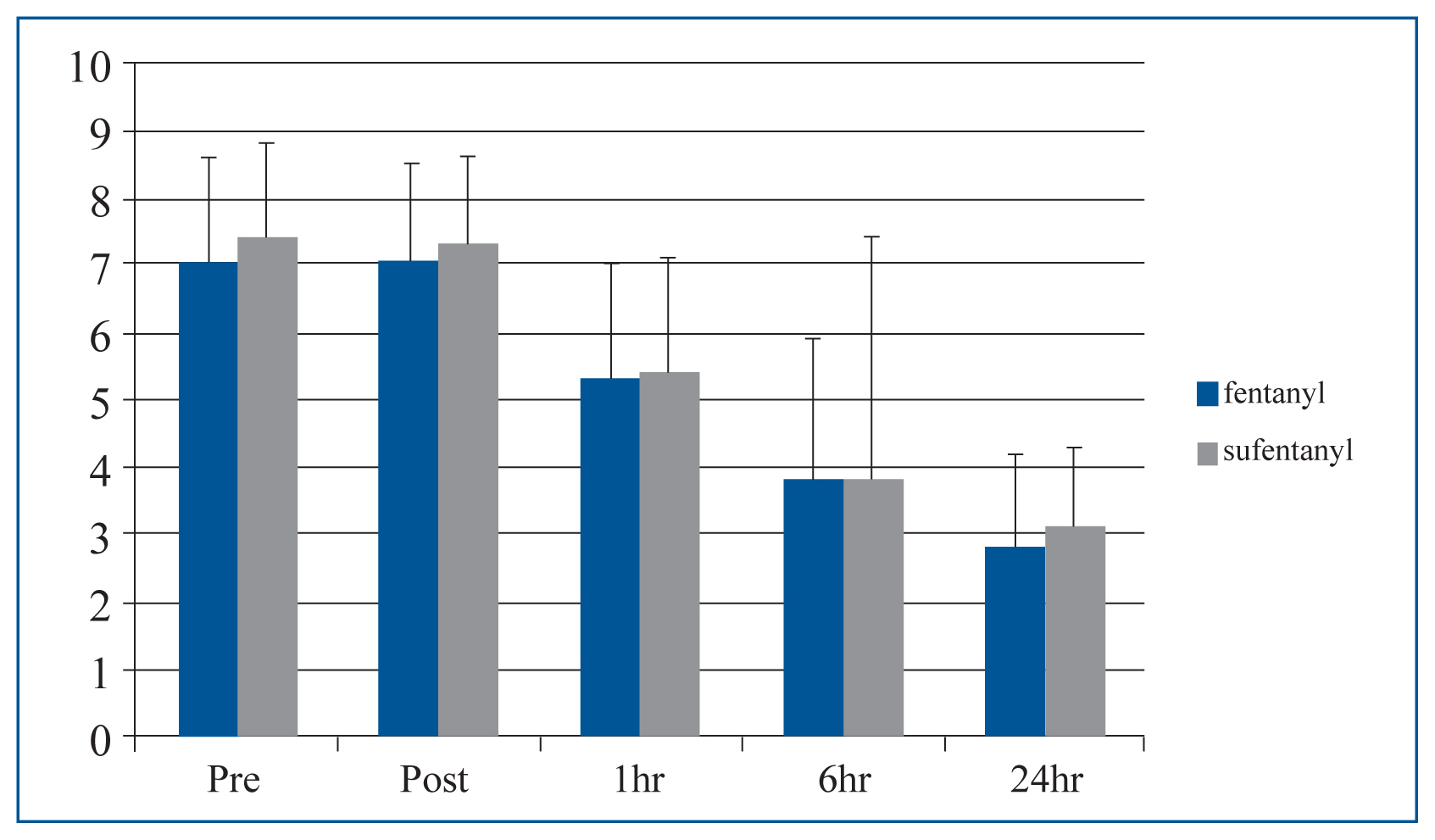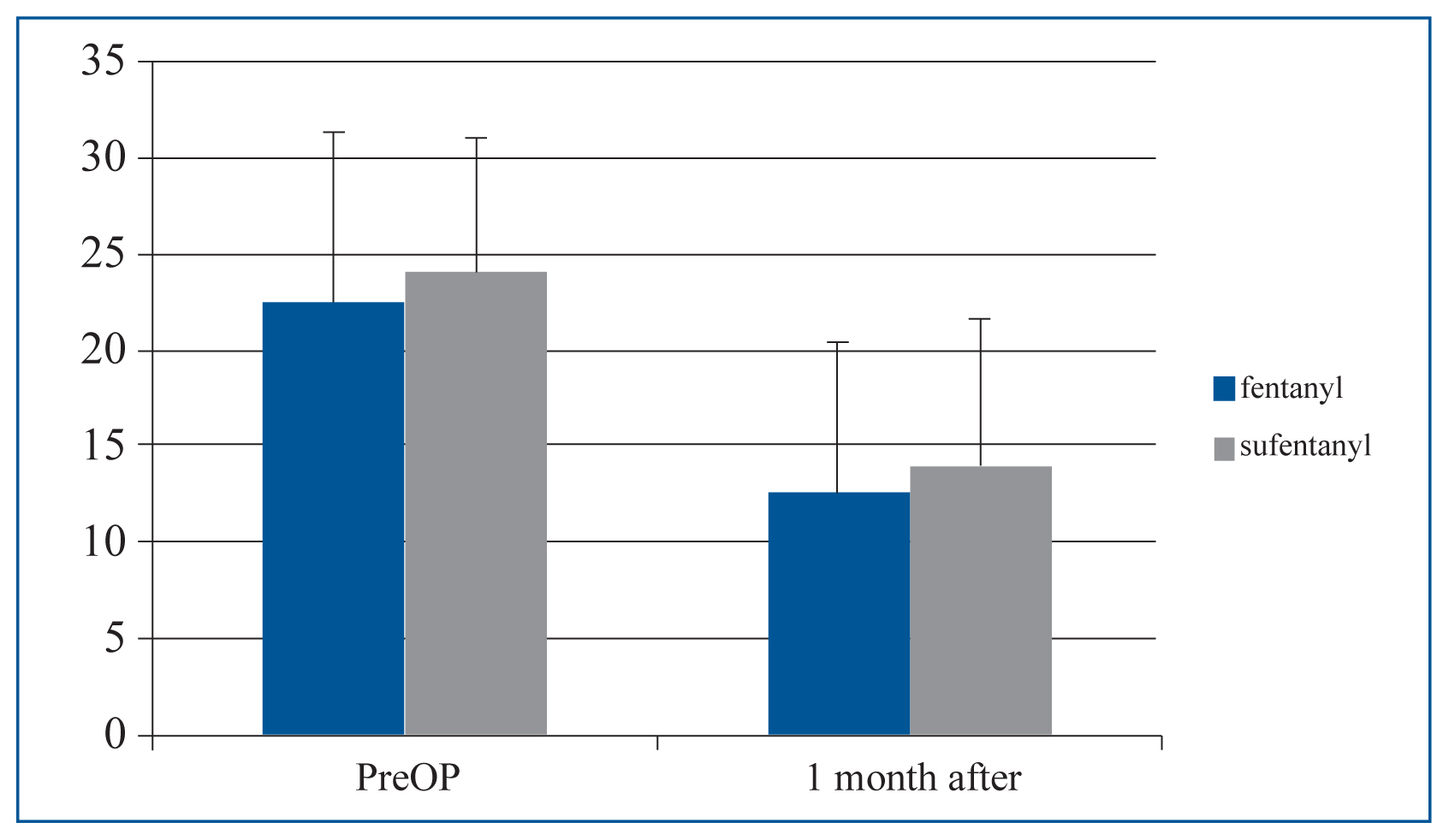J Korean Neurosurg Soc.
2017 Jan;60(1):54-59. 10.3340/jkns.2016.0707.007.
Comparison of the Effects of Sufentanil and Fentanyl Intravenous Patient Controlled Analgesia after Lumbar Fusion
- Affiliations
-
- 1Department of Neurosurgery, Inha University Hospital, Incheon, Korea. nsyoon@gmail.com
- 2Department of Neurosurgery, Na-Eun Hospital, Incheon, Korea.
- 3Department of Neurosurgery, Guro Cham TeunTeun Hospital, Seoul, Korea.
- 4Department of Anesthesiology, Inha university Hospital, Incheon, Korea.
- KMID: 2365587
- DOI: http://doi.org/10.3340/jkns.2016.0707.007
Abstract
OBJECTIVE
Postoperative pain is one of the major complaints of patients after lumbar fusion surgery. The authors evaluated the effects of intravenous patient controlled analgesia (IV-PCA) using fentanyl or sufentanil on postoperative pain management and pain-related complications.
METHODS
Forty-two patients that had undergone surgery with lumbar instrumentation and fusion at single or double levels constituted the study cohort. Patients were equally and randomly allocated to a sufentanil group (group S) or a fentanyl group (group F) for patient controlled analgesia (PCA). Group S received sufentanil at a dose of 4 μg/kg IV-PCA and group F received fentanyl 24 μg/kg IV-PCA. A numeric rating scale (NRS) of postoperative pain was applied before surgery, and immediately and at 1, 6, and 24 hours (hrs) after surgery. Oswestry disability index (ODI) scores were obtained before surgery and one month after surgery. Opioid-related side effects were also evaluated.
RESULTS
No significant intergroup difference was observed in NRS or ODI scores at any of the above-mentioned time points. Side effects were more frequent in group F. More specifically, nausea, vomiting rates were significantly higher (p=0.04), but pruritus, hypotension, and headache rates were non-significantly different in the two groups.
CONCLUSION
Sufentanil displayed no analgesic advantage over fentanyl postoperatively. However, sufentanil should be considerable for patients at high risk of GI issues, because it had lower postoperative nausea and vomiting rates than fentanyl.
Keyword
MeSH Terms
Figure
Reference
-
References
1. Bianconi M, Ferraro L, Ricci R, Zanoli G, Antonelli T, Giulia B, et al. The pharmacokinetics and efficacy of ropivacaine continuous wound instillation after spine fusion surgery. Anesth Analg. 98:166–172. 2004.
Article2. Bost P, Commun F, Albuisson E, Guichard C, Mom T, Eschalier A, et al. Postoperative pain assessment in head and neck cancer surgery: benefit of patient controlled analgesia (PCA). Ann Otolaryngol Chir Cervicofac. 116:154–161. 1999.3. Brownstein MJ. A brief history of opiates, opioid peptides, and opioid receptors. Proc Natl Acad Sci USA. 90:5391–5393. 1993.
Article4. Cata JP, Noguera EM, Parke E, Ebrahim Z, Kurz A, Kalfas I, et al. Patient-controlled epidural analgesia (PCEA) for postoperative pain control after lumbar spine surgery. J Neurosurg Anesthesiol. 20:256–260. 2008.
Article5. Cohen BE, Hartman MB, Wade JT, Miller JS, Gilbert R, Chapman TM. Postoperative pain control after lumbar spine fusion. Patient-controlled analgesia versus continuous epidural analgesia. Spine (Phila Pa 1976). 22:1892–1896. discussion 1896–1897. 1997.6. Cohen S, Amar D, Pantuck CB, Pantuck EJ, Goodman EJ, Widroff JS, et al. Postcesarean delivery epidural patient-controlled analgesia. Fentanyl or sufentanil? Anesthesiology. 78:486–491. 1993.7. Elder JB, Hoh DJ, Wang MY. Postoperative continuous paravertebral anesthetic infusion for pain control in lumbar spinal fusion surgery. Spine (Phila Pa 1976). 33:210–218. 2008.
Article8. Fisher CG, Belanger L, Gofton EG, Umedaly HS, Noonan VK, Abramson C, et al. Prospective randomized clinical trial comparing patient-controlled intravenous analgesia with patient-controlled epidural analgesia after lumbar spinal fusion. Spine (Phila Pa 1976). 28:739–743. 2003.
Article9. Geller E, Chrubasik J, Graf R, Chrubasik S, Schulte-Mönting J. A randomized double-blind comparison of epidural sufentanil versus intravenous sufentanil or epidural fentanyl analgesia after major abdominal surgery. Anesth Analg. 76:1243–1250. 1993.
Article10. Grieff AN, Ghobrial GM, Jallo J. Use of liposomal bupivacaine in the postoperative management of posterior spinal decompression. J Neurosurg Spine. 25:88–93. 2016.
Article11. Jayr C, Beaussier M, Gustafsson U, Leteurnier Y, Nathan N, Plaud B, et al. Continuous epidural infusion of ropivacaine for postoperative analgesia after major abdominal surgery: comparative study with i.v PCA morphine. Br J Anaesth. 81:887–892. 1998.
Article12. Jeon HR, Chae WS, Lee SJ, Lee JH, Cho SH, Kim SH, et al. A comparison of sufentanil and fentanyl for patient-controlled epidural analgesia in arthroplasty. Korean J Anesthesiol. 60:41–46. 2011.
Article13. Lee SH, Kim KH, Cheong SM, Kim S, Kooh M, Chin DK. A comparison of the effect of epidural patient-controlled analgesia with intravenous patient-controlled analgesia on pain control after posterior lumbar instrumented fusion. J Korean Neurosurg Soc. 50:205–208. 2011.
Article14. Lötsch J. Pharmacokinetic-pharmacodynamic modeling of opioids. J Pain Symptom Manage. 29(5 Suppl):S90–103. 2005.
Article15. Lu S, Ma SC, Wang YY, Zhu ZH, Fan HW, Zhao GQ. Comparison of pain relief between patient-controlled epidural analgesia and patient-controlled intravenous analgesia for patients undergoing spinal fusion surgeries. Arch Orthop Trauma Surg. 135:1247–1255. 2015.
Article16. Lutti MN, Vieira JL, Eickhoff DR, de Carli D, de Carvalho MA. Patient controlled analgesia with fentanyl or sufentanil in the postoperative period of knee ligament reconstruction: comparative study. Rev Bras Anesthesiol. 52:166–174. 2002.17. Maciejewski D. Sufentanil in anaesthesiology and intensive therapy. Anaesthesiol Intensive Ther. 44:35–41. 2012.18. Matsui H, Kanamori M, Terahata N, Miaki K, Makiyama N, Satone T, et al. Significance of patient-controlled analgesia in combination with continuous epidural block for patients who underwent posterior lumbar surgery. Eur Spine J. 7:120–124. 1998.
Article19. Ong CK, Lirk P, Seymour RA, Jenkins BJ. The efficacy of preemptive analgesia for acute postoperative pain management: a meta-analysis. Anesth Analg. 100:757–773. 2005.
Article20. Park SY, An HS, Lee SH, Suh SW, Kim JL, Yoon SJ. A prospective randomized comparative study of postoperative pain control using an epidural catheter in patients undergoing posterior lumbar interbody fusion. Eur Spine J. 25:1601–1607. 2016.
Article21. Schenk MR, Putzier M, Kügler B, Tohtz S, Voigt K, Schink T, et al. Postoperative analgesia after major spine surgery: patient-controlled epidural analgesia versus patient-controlled intravenous analgesia. Anesth Analg. 103:1311–1317. 2006.
Article22. Teng YH, Hu JS, Tsai SK, Liew C, Lui PW. Efficacy and adverse effects of patient-controlled epidural or intravenous analgesia after major surgery. Chang Gung Med J. 27:877–886. 2004.23. Wilhelm AJ, Dieleman HG. Epidural fentanyl and sufentanil for intra- and postoperative analgesia. A randomized, double-blind comparison. Pharm World Sci. 16:7–12. 1994.
Article24. Wilhelm W, Kreuer S. The place for short-acting opioids: special emphasis on remifentanil. Crit Care. 12(Suppl 3):S5. 2008.
Article
- Full Text Links
- Actions
-
Cited
- CITED
-
- Close
- Share
- Similar articles
-
- Comparison of Sufentanil and Fentanyl Added to Ropivacaine for Patient-Controlled Thoracic Epidural Analgesia
- A comparison of sufentanil and fentanyl for patient-controlled epidural analgesia in arthroplasty
- Comparison of Intrathecal Injection with Epidural Injection of Opioids and Local Anesthetics for Labor Analgesia
- Comparison of fentanyl and sufentanil added to 0.5% hyperbaric bupivacaine for spinal anesthesia in patients undergoing cesarean section
- Comparison of the Effects of Postoperative Continuous Plus Bolus Patient-Controlled Analgesia and of Bolus Patient-Controlled Analgesia in Children




